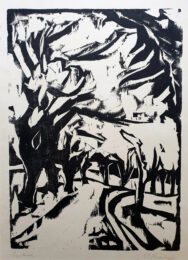


1880-1938
Born in Aschaffenberg in Bavaria, German artist Kirchner was painter and printmaker, and one of the leading figures in the 20th Century Expressionist movement. He originally studied architecture at the Königliche Technische Hochschule, but became more interested in their wider range of study subjects, including freehand drawing, perspective drawing and art history.
In 1905, Kirchner and three other architecture students (Fritz Bleyl, Karl Schmidt-Rottluff and Erich Heckel) formed Die Brücke (or The Bridge), an artist’s group, spelling the beginning of his commitment to art. Together, they avoided traditional styles and formed a new mode of art; a bridge (hence the name) between past and present – and the creation of Expressionist movement. Kirchner volunteered for the army in the First World War, but suffered a mental breakdown and was subsequently discharged.
After the War, his illness led to a move to Davos to paint a range of landscapes. However, his continuous conflicting ideas between past and present led him to be ostracised from the mainstream art world in Germany. This resulted in him becoming a victim of the Nazi ‘Degenerate Art’ campaign, wherein 600 of his works were either sold or destroyed. Kirchner became depressed as a consequence, and committed suicide in 1938.